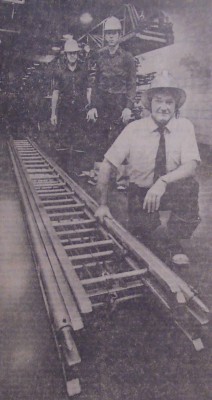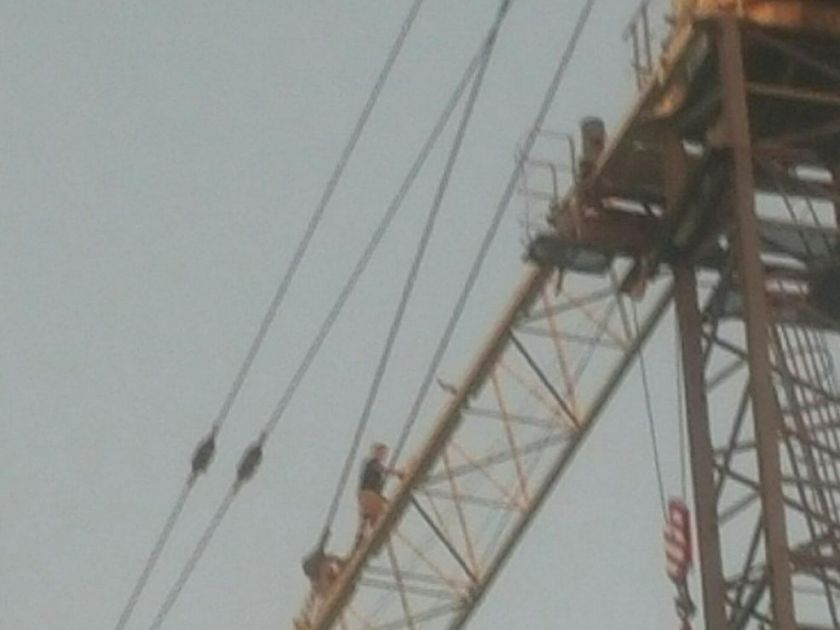
A fire consultant’s report recommends that aerial trucks be manned by six firefighters. Fire Capt. Len Everett, foreground, and his crew of John Baltzer and Dave Judge must wait for assistance at a fire before they can unload and extend the Bangor ladder, estimated to weigh 400 pounds.
This is a continuation (Continued from Page One)
Consultant’s report burns firefighters
fighters are assigned to each work shift to provide the manpower needed to maintain the minimum on-duty fire company manning necessary for the safety of citizens and of the firefighters engaged in this most hazardous of all civilian occupations.
The manpower shortage is made more acute by the fact that each fire station serves a considerably larger area than is common in many comparable cities so that the first arriving fire companies often are on the scene of a fire for several minutes before the assigned force arrives.
- The average fire department manning all comparable cities in North America is 1.65 employees per 1,000 persons protected. At present, London has only 1.20 fire employees per 1,000, including staff personnel.
On numerous occasions fire companies in London respond with only three men or half of the desirable standard manning.
To help alleviate the manpower deficiency, the rescue squad, housed at central fire hall, responds to all alarms for building fires through the city. While this provides desirable and useful supplemental manning, this apparatus cannot arrive at many fires in time, except in the core area to assist in getting the first hose stream in service and the primary mission of the rescue squad should be search and rescue, not initial fire attack. Effective initial attack on fires should not have to await the arrival of the rescue squad.
- Manpower, on occasion, at central firehall is seriously depleted. At no time, should less than a dozen men be on duty, exclusive of the chiefs and their aides.
At the present time at least two additional engine companies are needed for the proper protection of the city. When these are added, the fire force, exclusive of staff personnel should not be less than 340 officers and men. (Total complement now is 292).
With the staff personnel, this would represent only 1.48 employees per 1,000 population protected based on the present population increasing by several thousand residents per year.
- Engine company manning is a critical factor in initial fire attack. Five of the present nine engine companies are located in stations which house no other first-line apparatus and these units often are on the scene of a fire for several minutes before assigned help arrives. It is never safe for one man to work in a burning building alone. If the ladder carried on the engine is needed for rescue, this requires the entire company, or four men, for safe and efficient operation.
- On the average major fire departments in North America maintain a ratio of better than one truck company for each two engine companies. London is below this average and provides only one truck company for each 61,000 residents and 17.16 square miles served and most of these companies are undermanned.
- Existing fire stations do not provide needed coverage for extensive areas east of Highbury Avenue. There are about 10 square miles of territory which would receive prompt response from a needed No. 10 station on Dundas Street near Clarke Road. Last year engine companies made 492 responses east of Highbury. Priority should be given to providing an engine company in this area.
- Majority of fire alarms are for fires outside of buildings and these are handled normally by dispatching one company on a still alarm. In some cases, a single engine is sent to investigate the odor of smoke or gas in a building.
This is not a safe practice.
Recommended procedure is to send the full first alarm assignment and have the officer in charge relieve the units that are not needed. Some outside fires are handled by sending the small service truck, housed at central firehall with a single firefighter.

A fire consultant’s report recommends that aerial trucks be manned by six firefighters. Fire Capt. Len Everett, foreground, and his crew of John Baltzer and Dave Judge must wait for assistance at a fire before they can unload and extend the Bangor ladder, estimated to weigh 400 pounds.
This is a continuation (Continued from Page One)
Consultant’s report burns firefighters
fighters are assigned to each work shift to provide the manpower needed to maintain the minimum on-duty fire company manning necessary for the safety of citizens and of the firefighters engaged in this most hazardous of all civilian occupations.
The manpower shortage is made more acute by the fact that each fire station serves a considerably larger area than is common in many comparable cities so that the first arriving fire companies often are on the scene of a fire for several minutes before the assigned force arrives.
- The average fire department manning all comparable cities in North America is 1.65 employees per 1,000 persons protected. At present, London has only 1.20 fire employees per 1,000, including staff personnel.
On numerous occasions fire companies in London respond with only three men or half of the desirable standard manning.
To help alleviate the manpower deficiency, the rescue squad, housed at central fire hall, responds to all alarms for building fires through the city. While this provides desirable and useful supplemental manning, this apparatus cannot arrive at many fires in time, except in the core area to assist in getting the first hose stream in service and the primary mission of the rescue squad should be search and rescue, not initial fire attack. Effective initial attack on fires should not have to await the arrival of the rescue squad.
- Manpower, on occasion, at central firehall is seriously depleted. At no time, should less than a dozen men be on duty, exclusive of the chiefs and their aides.
At the present time at least two additional engine companies are needed for the proper protection of the city. When these are added, the fire force, exclusive of staff personnel should not be less than 340 officers and men. (Total complement now is 292).
With the staff personnel, this would represent only 1.48 employees per 1,000 population protected based on the present population increasing by several thousand residents per year.
- Engine company manning is a critical factor in initial fire attack. Five of the present nine engine companies are located in stations which house no other first-line apparatus and these units often are on the scene of a fire for several minutes before assigned help arrives. It is never safe for one man to work in a burning building alone. If the ladder carried on the engine is needed for rescue, this requires the entire company, or four men, for safe and efficient operation.
- On the average major fire departments in North America maintain a ratio of better than one truck company for each two engine companies. London is below this average and provides only one truck company for each 61,000 residents and 17.16 square miles served and most of these companies are undermanned.
- Existing fire stations do not provide needed coverage for extensive areas east of Highbury Avenue. There are about 10 square miles of territory which would receive prompt response from a needed No. 10 station on Dundas Street near Clarke Road. Last year engine companies made 492 responses east of Highbury. Priority should be given to providing an engine company in this area.
- Majority of fire alarms are for fires outside of buildings and these are handled normally by dispatching one company on a still alarm. In some cases, a single engine is sent to investigate the odor of smoke or gas in a building.
This is not a safe practice.
Recommended procedure is to send the full first alarm assignment and have the officer in charge relieve the units that are not needed. Some outside fires are handled by sending the small service truck, housed at central firehall with a single firefighter.





